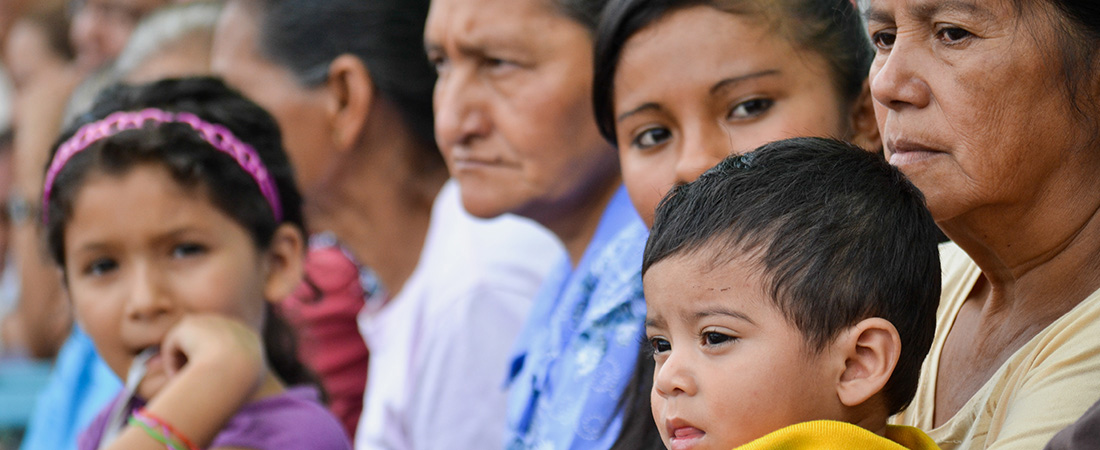In Search of a Better Future

- 40% of Guatemala’s population is between the ages of 0 and 14. By contrast, 20% of the U.S. population falls within the same age range. [The World Bank]
- Nearly one-quarter of youth aged 15–19 in Honduras, El Salvador, and Guatemala are neither studying nor working. [The World Bank]
- 64.5% of Hondurans live below the poverty line. [The World Bank]
- Honduras is the most dangerous country in the world, with a homicide rate of 90.4 per 100,000 residents. [U.N. Office for Drugs and Crime Global Study on Homicide]
- There has been a 117% increase in the number of unaccompanied children aged 12 or younger apprehended at the U.S. border this year compared with FY 2012. For this age group, the number of apprehended, unaccompanied girls has increased 140% over FY 2012. [Pew Research Center]
The recent flood of unaccompanied minors from Central American countries arriving at the United States’ southern border has drawn attention to the desperate conditions that these children face in their home countries. But what level of violence and poverty could cause so many parents to send their children on such a long, perilous journey?
EDC’s Gustavo Payan knows something about the conditions that these families face. Raised in Ciudad Juarez, Mexico, Payan saw the impact of widespread violence on society. Today, as a development practitioner who frequently travels to Honduras and Guatemala, Payan works to build programs that give young people—and their families—the promise of a better life.
Q: What are some of the factors contributing to youth violence in Honduras, El Salvador, and Guatemala?
Payan: It is a combination of numerous factors, but I will focus on three: gangs and criminal organizations, limited opportunities, and weak institutions. Formal law enforcement entities have struggled to stem the violence because it is so widespread, and corruption is common. Educational and decent livelihood opportunities are limited. And geographically, crime and insecurity are not contained within poor communities—they are everywhere.
So in Honduras, El Salvador, and Guatemala, you have a situation where crime is widespread, where nobody is exempt from it, and where there are few formal institutions capable of stopping it or providing peaceful alternatives. It’s not an easy issue to solve. And murder is only one component of the violence. These countries also have high levels of sexual assault, armed robbery, school-based violence, and extortion.
Q: How is the issue of youth violence related to the current crisis of undocumented minors crossing into the United States?
Payan: Many parents in these countries recognize the hopelessness of their situation. Their children have no access to schools—or, worse, the schools have become a place where gangs recruit. Extortion is rampant, making it very difficult for people to operate their own businesses without fear of violence. For example, it was recently reported that in 2012, 17,500 small businesses in Honduras closed as a direct result of extortion, affecting more than 25,000 families. Sadly, a robust, illegal human smuggling market has sprouted, taking advantage of people’s desperation and ignorance.
These people care about their kids. In the United States, parents see a glimmer of hope for their children to have a better life. They think that traveling north, as difficult and dangerous as it may be, is a more hopeful alternative than staying at home.
Q: How can we help young people in these countries find alternatives to violence?
Payan: It’s important to invest in grassroots and community organizations that give young people positive, productive options for their lives. It’s just as important that government policies enable promising programs to work. Families must be a focus of violence prevention and reduction efforts. And when we design programs with this population in mind, we must also try to understand that many of these young people have grown up within a society of mistrust and violence and have experienced a high level of trauma. All of this affects how they learn and behave. They have little sense that they can do anything to improve their own lives.
Young people’s potential is enormous, and we can help them develop the skills and confidence to change behaviors. This was one of the big goals of Proyecto METAS, a USAID-funded project in Honduras. The project’s workforce trainings gave young people actual labor skills that they could apply and helped give them the self-confidence to succeed.
Q: Do workforce development programs like METAS offer young people a realistic alternative?
Payan: I don’t think any single program can be a full alternative. For progress to be made, we need to look well beyond workforce development. Violence affects the whole community, so violence prevention needs to involve the whole community—families, schools, hospitals, churches, community organizations, law enforcement, and businesses.
Obviously, this is a tremendous challenge. You want to reach as many young people as possible. And you also want the programming to be personally meaningful so that it makes a difference in their lives. Over the past four years, Proyecto METAS has succeeded in reaching over 50,000 young people in Honduras—but we need to take the intervention deeper by including career and psycho-social support services. Education is still the best strategy to give people the tools to rebuild their lives. Maybe it won’t end poverty in a single generation, but at least it can limit the impact it is having right now.